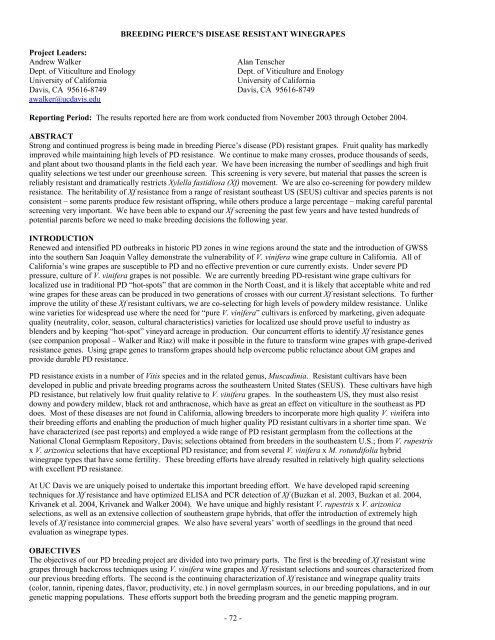Impact Of Host Plant Xylem Fluid On Xylella Fastidiosa Multiplication ...
Impact Of Host Plant Xylem Fluid On Xylella Fastidiosa Multiplication ...
Impact Of Host Plant Xylem Fluid On Xylella Fastidiosa Multiplication ...
Create successful ePaper yourself
Turn your PDF publications into a flip-book with our unique Google optimized e-Paper software.
BREEDING PIERCE’S DISEASE RESISTANT WINEGRAPES<br />
Project Leaders:<br />
Andrew Walker<br />
Dept. of Viticulture and Enology<br />
University of California<br />
Davis, CA 95616-8749<br />
awalker@ucdavis.edu<br />
Alan Tenscher<br />
Dept. of Viticulture and Enology<br />
University of California<br />
Davis, CA 95616-8749<br />
Reporting Period: The results reported here are from work conducted from November 2003 through October 2004.<br />
ABSTRACT<br />
Strong and continued progress is being made in breeding Pierce’s disease (PD) resistant grapes. Fruit quality has markedly<br />
improved while maintaining high levels of PD resistance. We continue to make many crosses, produce thousands of seeds,<br />
and plant about two thousand plants in the field each year. We have been increasing the number of seedlings and high fruit<br />
quality selections we test under our greenhouse screen. This screening is very severe, but material that passes the screen is<br />
reliably resistant and dramatically restricts <strong>Xylella</strong> fastidiosa (Xf) movement. We are also co-screening for powdery mildew<br />
resistance. The heritability of Xf resistance from a range of resistant southeast US (SEUS) cultivar and species parents is not<br />
consistent – some parents produce few resistant offspring, while others produce a large percentage – making careful parental<br />
screening very important. We have been able to expand our Xf screening the past few years and have tested hundreds of<br />
potential parents before we need to make breeding decisions the following year.<br />
INTRODUCTION<br />
Renewed and intensified PD outbreaks in historic PD zones in wine regions around the state and the introduction of GWSS<br />
into the southern San Joaquin Valley demonstrate the vulnerability of V. vinifera wine grape culture in California. All of<br />
California’s wine grapes are susceptible to PD and no effective prevention or cure currently exists. Under severe PD<br />
pressure, culture of V. vinifera grapes is not possible. We are currently breeding PD-resistant wine grape cultivars for<br />
localized use in traditional PD “hot-spots” that are common in the North Coast, and it is likely that acceptable white and red<br />
wine grapes for these areas can be produced in two generations of crosses with our current Xf resistant selections. To further<br />
improve the utility of these Xf resistant cultivars, we are co-selecting for high levels of powdery mildew resistance. Unlike<br />
wine varieties for widespread use where the need for “pure V. vinifera” cultivars is enforced by marketing, given adequate<br />
quality (neutrality, color, season, cultural characteristics) varieties for localized use should prove useful to industry as<br />
blenders and by keeping “hot-spot” vineyard acreage in production. Our concurrent efforts to identify Xf resistance genes<br />
(see companion proposal – Walker and Riaz) will make it possible in the future to transform wine grapes with grape-derived<br />
resistance genes. Using grape genes to transform grapes should help overcome public reluctance about GM grapes and<br />
provide durable PD resistance.<br />
PD resistance exists in a number of Vitis species and in the related genus, Muscadinia. Resistant cultivars have been<br />
developed in public and private breeding programs across the southeastern United States (SEUS). These cultivars have high<br />
PD resistance, but relatively low fruit quality relative to V. vinifera grapes. In the southeastern US, they must also resist<br />
downy and powdery mildew, black rot and anthracnose, which have as great an effect on viticulture in the southeast as PD<br />
does. Most of these diseases are not found in California, allowing breeders to incorporate more high quality V. vinifera into<br />
their breeding efforts and enabling the production of much higher quality PD resistant cultivars in a shorter time span. We<br />
have characterized (see past reports) and employed a wide range of PD resistant germplasm from the collections at the<br />
National Clonal Germplasm Repository, Davis; selections obtained from breeders in the southeastern U.S.; from V. rupestris<br />
x V. arizonica selections that have exceptional PD resistance; and from several V. vinifera x M. rotundifolia hybrid<br />
winegrape types that have some fertility. These breeding efforts have already resulted in relatively high quality selections<br />
with excellent PD resistance.<br />
At UC Davis we are uniquely poised to undertake this important breeding effort. We have developed rapid screening<br />
techniques for Xf resistance and have optimized ELISA and PCR detection of Xf (Buzkan et al. 2003, Buzkan et al. 2004,<br />
Krivanek et al. 2004, Krivanek and Walker 2004). We have unique and highly resistant V. rupestris x V. arizonica<br />
selections, as well as an extensive collection of southeastern grape hybrids, that offer the introduction of extremely high<br />
levels of Xf resistance into commercial grapes. We also have several years’ worth of seedlings in the ground that need<br />
evaluation as winegrape types.<br />
OBJECTIVES<br />
The objectives of our PD breeding project are divided into two primary parts. The first is the breeding of Xf resistant wine<br />
grapes through backcross techniques using V. vinifera wine grapes and Xf resistant selections and sources characterized from<br />
our previous breeding efforts. The second is the continuing characterization of Xf resistance and winegrape quality traits<br />
(color, tannin, ripening dates, flavor, productivity, etc.) in novel germplasm sources, in our breeding populations, and in our<br />
genetic mapping populations. These efforts support both the breeding program and the genetic mapping program.<br />
- 72 -











